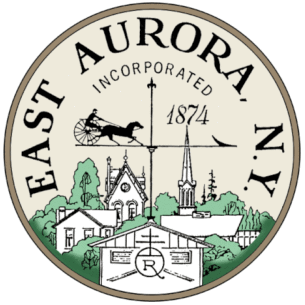
Menu
The East Aurora Historic Preservation Commission (HPC) was established in 1987 when the Village Board adopted a Historic Preservation Ordinance (Village Code Chapter 156).
Members of the Commission are appointed by the Mayor to four-year terms. There are nine members with a mix of skills and qualifications, including an architect, a historian, an attorney, a resident of a historic district and other persons committed to historic preservation, all of whom also have a known interest in the field.
The Commission generally meets the 2nd Wednesday of each month at 6:30 p.m. Contact the Village Clerk's Office at 716-652-6000, option 4 for additional information.
In 2013, the Historic Preservation Commission for the Village of East Aurora completed a Reconnaissance Level Survey of Historic Architectural Resources. The report was prepared by Martin Wachadlo and Francis R. Kowsky.
A full copy of this report (205 pages) can be downloaded in four parts: Main Report, Annotated List 1, Annotated List 2, Annotated List 3.
The general purpose of the Commission is to promote historic preservation in East Aurora. The Village and its residents take great pride in its many cultural and historic resources of local, regional and national importance. Promoting historic preservation is a way to honor and preserve the legacy of generations past for present and future generations who may live in or visit our community. Historic preservation also promotes the regional goal of heritage tourism and our community as a destination for visitors to Western New York.
The Commission's primary activities include:
In the judgment of the Commission, and subject to the approval of the Village Board, a property may be designated as a landmark if it:
Furthermore, a group of properties may be designated as an historic district if the group:
For example, the Roycroft Campus constitutes an historic district.
No. The State and National Registers are distinct from local designation as a landmark by the Village of East Aurora.
Detailed instructions and forms are available through the Village Clerk's Office at Village Hall or by visiting the forms page of this website.
There are tangible and intangible benefits to designation of a property as a landmark. Foremost is formal recognition of the unique historical importance of the property. It honors the property itself as a valued source of pride not only to the property owner, but also to the community as a whole. The designation also protects the property against demolition or major modifications which would alter the character of the property. The owner of the property may also obtain a plaque (at the owner's expense) and/or certificate commemorating the property's designation as a landmark.
Subject to separate application and assessor approval, if the owner of a landmark property expends funds for rehabilitation of the exterior or public interior of the landmark, the property may also qualify for a phased Village real property tax exemption for any increase in value attributable to the rehabilitation.
The owner of a landmark is also a steward of the property. As such, before an owner undertakes major exterior alterations, reconstruction, new construction, demolition or other material changes to the exterior of a landmark which would be visible from a public street or right-of-way, the owner must obtain a certificate of appropriateness from the Commission. Examples would include building an addition, removing a porch, replacing the windows or changing the siding.
No. Ordinary maintenance and repairs which do not involve a change in design, material, color or outward appearance do not require approval of the Commission. Examples would include repairing a window or replacing a roof with like material.
The decision of the Commission is based upon the following principles:
Further, in assessing compatibility, the Commission considers the following factors:
No. A certificate of appropriateness is not a building permit. If a certificate of appropriateness is required for a project, it is in addition to, and not in lieu of, any other permit or approval that may be required for a project of that type (e.g., Zoning Board or Planning Commission approval, if applicable).
Detailed instructions and forms are available through the Village Clerk's Office at Village Hall or by visiting the forms page of this website.
Questions can be directed to Mary Ann Colopy, Chairwoman of the Commission at 845-416-8606 or email mac.colopy@gmail.com.